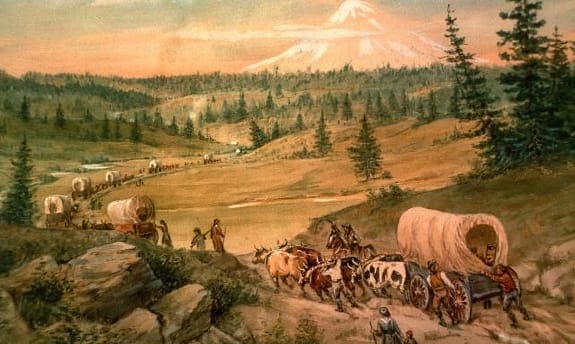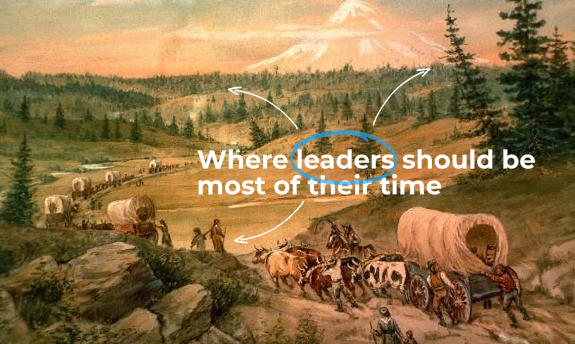Recently, I came across a helpful visualization of what Leadership means in times of Digital Transformation. Let me show you.
Imagine your company like a trek of settlers. They want to build a better future for themselves and are looking for the right piece of land on which to establish their new settlement. Just like the people depicted in Jackson’s painting:

“What does it have to do with Digital Transformation?”, you ask. Well, your company is in one spot today and wants to be in a different, more fruitful spot tomorrow. So, this group of people starts to move. And just like detailed maps or GPS didn’t exist in the 19th century, today’s companies don’t have the means of knowing upfront if their envisioned spot even exists, where exactly it’s located nor what the best route is to reach it. They only know the general direction.
Yet they believe that starting to move in that direction is better than to sit tight. Just like the settlers.
How Migration Transforms the Role of Leadership ¶
Alright, now let’s discuss the role of leadership in this scenario. Where are the leaders, what do they do? Is their role different while the trek is moving—or is it the same as back when people were living in their previous settlement?
The key difference between settlement and migration is the environment:
- In the settlement, the environment is relatively stable. It and its dangers are well known. As settler, you’re allowed to focus on exploitation and optimization.
- During migration, the environment keeps changing rapidly as you move along your route. It and its dangers are vastly unknown. As migrant, you’re forced to focus on exploration and innovation.
That’s already the answer: In times of Digital Transformation (or any other transformation, for that matter), leaders are forced to assume a role as explorers and innovators.

What Do Explorers Do Exactly? ¶
Here are a few ideas: They …
- … travel light, leave the trek as scouts and venture ahead in different directions
- … select a few fellows, both loyal and critical, to accompany them and learn together
- … identify opportunities and risks, then validate them with quick experiments
- … return and pass on the essence of their learnings to the rest of the group
- … observe the people in the trek and become aware of their challenges and needs
- … reassess the trek’s route based on these learnings and direct the entire trek in new directions if necessary
- … motivate people to go through harsh environments to reach their destination faster
In contemporary management terms, it means: Leaders go constantly to conferences, seminars and trainings. For every of these “explorations”, they pick the right companions to help the entire company learn as much and as fast as possible. They understand innovation as quick and effective way of de-risking the constant change. Leaders return often to camp and communicate the summary of their experiences. They listen to the needs of employees and specifically consider them on their next explorations. Together with them, they develop ideas on how and when to change strategies. Leaders reassure and motivate others to follow the trails they blazed.
So far, it seems like common sense, doesn’t it? Now let’s take a look at:
What Explorers Don’t Do ¶
This is where it gets interesting. They …
- … don’t stay with the trek and get comfortable for long
- … don’t ask others to do the reconnaissance out in the unknown for them
- … don’t tell others how to fix broken wheels
- … don’t fix broken wheels themselves
Again, translating this to today’s business slang: Leaders don’t remain in their corner offices and internal affairs all day. They don’t give instructions on how to run the business and, most of all, they don’t run any part of business on an operational level.
Leaders are paid to go into the wild, dangerous unknown. Leaders work on the business (outside-in), not in the business (inside-out). For the latter, they trust, delegate and serve.

Looking at calendars of many line managers however, you get the impression that they’re knee deep and hands on in project meetings, steering committees, and task forces—fixing whatever’s broken. Very few days are dedicated to exploration and innovation, if at all.
They take decisions based on the shortsightedness of working in the business all day, every day. Even if they’re lucky and employees start roaming and scouting the environment on their own, managers are quick to dismiss reports from returning scouts as they haven’t shared the same experiences firsthand.
Lead Your Managers to Become Leaders ¶
If you’re a leader and read this, you’re already leaving the comfort zone and sticking your neck out as it should be. Keep going!
Based on my recent experience though, you’re reading this probably more from another perspective: Your industry is transforming, yet your line managers are still stuck in their mode of exploitation and optimization. They haven’t switched to exploration and innovation.
The question becomes:
How can you lead managers to become exploration and innovation leaders?
Easy, right? They just have to open their eyes and learn.
Unfortunately, it’s more complicated than that and depends on two things:
- Ability: Managers enjoyed major success as exploiters and optimizers and advanced their careers in these roles. To recognize that these roles that made them so successful in the past are now the exact same factors that will make them unsuccessful in the future, is hard to wrap your head around. To act on it, is difficult, too: You first have to unlearn old habits, reflexes, intuitions, and deeply rooted mental models—before you can learn the new roles. Not everyone is able to achieve that.
- Willingness: Chances of success are closely related with degree of joy. The more you enjoy doing something, the better are your chances of success doing it. This means in turn that you’re asking successful exploiters and optimizers to stop doing something that they enjoyed. In turn, you’re asking them to start something with uncertain degree of joy. Not everyone wants to change that.
This phenomenon even has a name: the Innovator’s Dilemma.
In the end, here’s how you can lead the way: Help them recognize the situation and offer un-/learning support to address their ability. Incentivize the change of roles with an appropriate reward system to address their willingness.
And yes, this also applies if you’re their subordinate and they’re your superiors. It’s called “manage up.”
Conclusion ¶
In this article, I shared an interpretation of leadership in times of transformation: by analogy with a trek of migrating settlers.
I showed the difference between operating in a settlement with a rather stable environment—and migrating away from a previous settlement through a dynamic environment. Hence, leadership roles change from exploitation and optimization towards exploration and innovation.
I translated the analogy back to today’s business world and briefly showed what, in general terms, can be done to help managers become transformation leaders.
Disclaimer ¶
This article is an echo to what I learned in an OKR training by Stefan Engels in late 2021.

Michael Schmidle
Founder of PrioMind. Start-up consultant, hobby music producer and blogger. Opinionated about technology, strategy, and leadership. In love with Mexico. This blog reflects my personal views.
Oct 6, 2024 · 4min read
Revolutionizing Decision-Making
Last year, I shared a simple framework for making better decisions. Little did I know it would spark a journey that led to creating PrioMind, an app that’s revolutionizing how we approach choices. Here’s the story of how four criteria evolved into a powerful decision-making tool, and what I’ve learned along the way. Continue…
Jun 4, 2022 · 6min read
The Power of Subtractive Thinking
What’s better: more success or less failure? More possibilities or less impossibilities? Let’s take a look at the seemingly pointless question—and discover the surprising answer. Continue…
Oct 11, 2021 · 6min read
The Best of Both VUCAs
Ever heard of VUCA—as in: Volatility, Uncertainty, Complexity, and Ambiguity? Ever thought that these aspects could actually be beneficial on a certain level? Let’s find out. Continue…
Sep 12, 2021 · 6min read
Applying Design Thinking to a Pandemic
Everybody seems to have strong opinions about the best way to get out of the COVID-19 pandemic—to the point that makes it really tough to, indeed, get out. Maybe Design Thinking can help? Continue…



